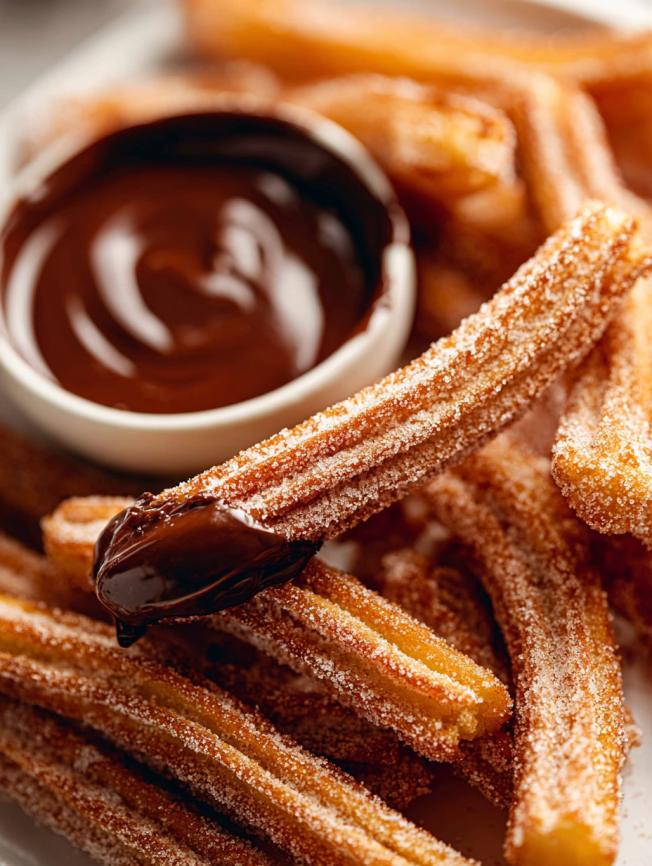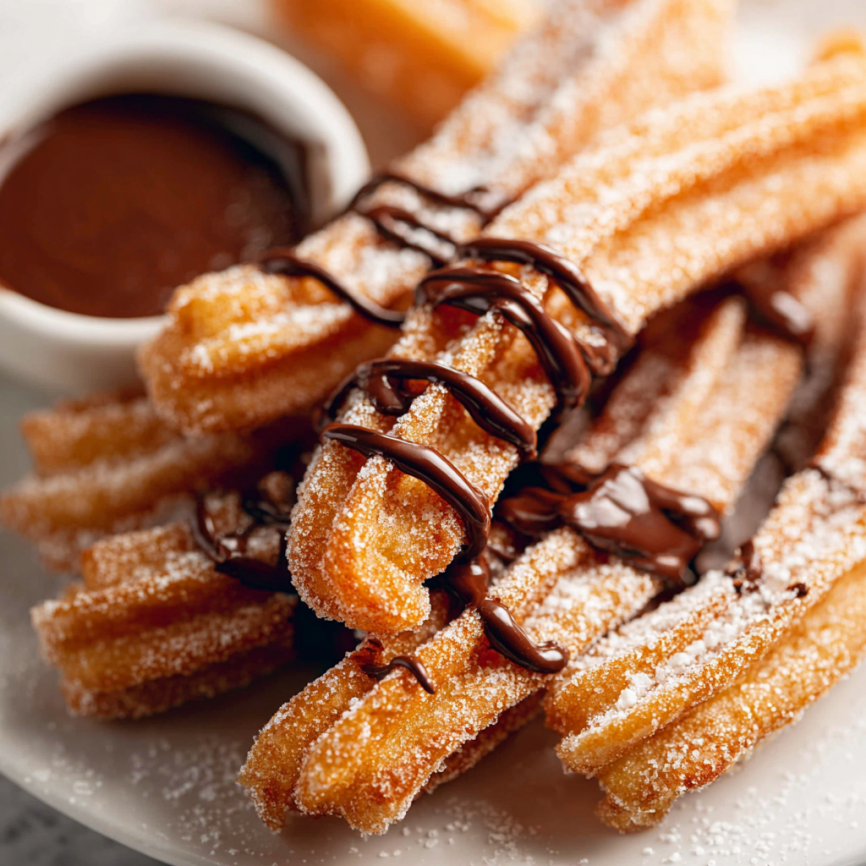The first time I bit into a freshly made churro at a Spanish street fair, I knew my life had changed forever. That perfect contrast between the crispy, ridged exterior and the pillowy-soft interior, all wrapped in a cloud of cinnamon sugar, was nothing short of magical. What seemed like an impossible treat to recreate at home turned out to be surprisingly achievable with the right technique and a little patience.
Now, whenever the craving strikes or I want to transport my family to a European café, I turn to this foolproof churros recipe. The secret lies in creating the perfect choux pastry dough and maintaining the ideal oil temperature – two techniques that, once mastered, will have you making churros that rival any bakery or street vendor.
Why This Churros Recipe Will Become Your New Obsession
Authentic Texture Perfection: These churros achieve the coveted crispy exterior that gives way to an incredibly tender, almost custard-like interior. The ridged surface created by the star tip perfectly captures and holds the cinnamon sugar coating.
Surprisingly Simple Technique: Despite their impressive appearance, churros use basic pantry ingredients and straightforward cooking methods. Furthermore, the choux pastry technique is forgiving and actually improves with practice.
Instant Crowd Pleaser: Whether served at brunch, as an afternoon snack, or an elegant dessert, churros never fail to impress. Additionally, they’re best enjoyed fresh and warm, creating a communal cooking experience that brings people together.
Versatile Serving Options: While delicious on their own, churros serve as the perfect vehicle for various dipping sauces and accompaniments. Moreover, they can be dressed up or down depending on the occasion.
Essential Ingredients
For the Cinnamon Sugar Coating:
- 1/2 cup granulated sugar – Creates the sweet, sparkly exterior
- 1/2 teaspoon ground cinnamon – Adds warmth and classic churro flavor
For the Churro Dough:
- 4 ounces butter – Provides richness and helps create the tender texture
- 1 cup water – The liquid base for the choux pastry
- 2 tablespoons white granulated sugar – Subtle sweetness in the dough itself
- 1 teaspoon pure vanilla extract – Enhances the overall flavor profile
- 3/4 teaspoon ground cinnamon – Infuses the dough with warm spice
- 1/2 teaspoon salt – Balances sweetness and enhances other flavors
- 1 1/4 cups all-purpose flour – The structure-building foundation
- 2 large eggs at room temperature – Creates the signature light, airy texture
Equipment Essentials:
- Large star tip pastry nozzle (Wilton 1M or Ateco 845/846)
- Strong pastry bag or piping bag
- Deep pot or heavy skillet for frying
- Candy thermometer for oil temperature
- Kitchen scissors for cutting dough
Step-by-Step Instructions
Setting Up Your Workspace
Before beginning any cooking, proper preparation ensures smooth execution and perfect results. Combine the coating sugar and cinnamon in a shallow bowl, whisking to distribute evenly. This mixture should be ready and waiting for your hot churros.
Next, line a large plate with a double layer of paper towels to drain the finished churros. Having this ready prevents any scrambling once the frying begins. Fill your deep pot or heavy skillet with 1 1/2 to 2 cups of neutral oil, ensuring at least 2 inches of depth for proper frying.
Creating the Perfect Choux Pastry
In a medium-sized saucepan, melt the butter over medium heat until completely liquefied. Add the water, sugar, vanilla extract, cinnamon, and salt to the melted butter. Bring this mixture to a gentle simmer, stirring occasionally to ensure everything dissolves properly.
Allow the mixture to simmer for approximately 5 minutes, which helps concentrate the flavors and prepare the liquid for flour incorporation. Remove the pan from heat and immediately add the flour all at once. Using a large wooden spoon, stir vigorously until the mixture forms a cohesive ball that pulls away from the sides of the pan.
Temperature Control and Timing
Transfer the hot dough to a clean bowl and allow it to cool for about 10 minutes, or until it’s just warm to the touch. This cooling period is crucial – adding eggs to dough that’s too hot will scramble them, while dough that’s too cool won’t incorporate properly.
During this cooling time, heat your oil over medium-high heat to exactly 360°F (180°C). Maintaining this temperature throughout frying ensures perfectly crispy churros without greasy interiors.
Incorporating the Eggs
Once the dough has cooled appropriately, add the first egg and beat vigorously with a wooden spoon or electric mixer. Initially, the mixture may look broken or curdled, but continue beating persistently until it becomes smooth and cohesive. This process typically takes 2-3 minutes of continuous mixing.
Add the second egg and repeat the vigorous mixing process. The final dough should be smooth, glossy, and pipeable, with a consistency similar to thick mashed potatoes.
Piping and Shaping Techniques
Transfer the prepared dough to a strong pastry bag fitted with a large open star tip. If you don’t have a pastry bag, a large zip-lock bag with the corner cut off works as an alternative, though the ridges won’t be as pronounced.
Before piping, lightly oil your kitchen scissors – this prevents the dough from sticking and ensures clean cuts. The oiled scissors are essential for creating uniform churro lengths.

The Frying Process
Proper Piping Technique
Working directly over the hot oil, carefully pipe 5-6 inch strips of dough, using the oiled scissors to cut each churro cleanly. The dough should sizzle immediately upon contact with the oil, indicating the correct temperature.
Fry only 4-5 churros at a time to prevent overcrowding, which can lower the oil temperature and result in greasy, soggy churros. Overcrowding also makes turning and monitoring more difficult.
Achieving Golden Perfection
Cook each batch for approximately 2 minutes per side, turning carefully with tongs or a slotted spoon. The churros should develop a deep golden-brown color and sound hollow when tapped lightly.
Immediately transfer the finished churros to the paper towel-lined plate for just a few seconds to remove excess oil. While still warm, roll each churro in the prepared cinnamon sugar mixture, ensuring complete coverage.
Serving Suggestions and Pairings
Classic Accompaniments
Traditional churros shine when served with thick, rich chocolate sauce for dipping. Spanish-style hot chocolate, made with dark chocolate and a touch of cornstarch for thickness, provides the authentic experience.
Alternatively, warm caramel sauce, dulce de leche, or even Nutella create delicious modern variations. Fresh fruit like strawberries or bananas add a refreshing contrast to the rich, sweet churros.
Creative Presentation Ideas
For elegant entertaining, serve churros standing upright in tall glasses with small bowls of dipping sauces. This presentation looks impressive while keeping the churros crisp and accessible.
Consider creating a churros bar with multiple dipping options, allowing guests to customize their experience. Include both sweet and slightly savory options like salted caramel or spiced chocolate.
Beverage Pairings
Coffee and churros form a classic combination, with the bitter notes balancing the sweet cinnamon coating. Spanish café con leche or Mexican café de olla complement the flavors particularly well.
For special occasions, champagne or prosecco creates an unexpected but delightful pairing, while horchata provides a traditional Spanish beverage option.
Creative Recipe Variations
Flavor Enhancements
Transform basic churros by adding orange zest to the dough for a citrus twist, or incorporate espresso powder for coffee-flavored churros. These subtle additions create sophisticated variations without overwhelming the classic appeal.
Filled Churros
Create gourmet filled churros by piping pastry cream, dulce de leche, or chocolate ganache into the centers after cooking. Use a small round tip to create a hole, then pipe the filling carefully.
Alternative Coatings
While cinnamon sugar remains the classic choice, experiment with other coatings like powdered sugar with vanilla, cocoa powder mixed with sugar, or even finely chopped nuts for added texture.
Seasonal Adaptations
During fall, add pumpkin pie spice to both the dough and coating. For winter holidays, incorporate gingerbread spices or serve with eggnog-flavored dipping sauce.
Make-Ahead Strategies and Storage
Advance Preparation Options
While churros are best enjoyed immediately, the dough can be prepared several hours ahead and kept covered at room temperature. This actually allows the flavors to develop more fully.
Reheating Techniques
If you must store cooked churros, place them on a wire rack to maintain crispness. Reheat in a 350°F oven for 3-4 minutes to restore the crispy exterior, though they’ll never quite match the texture of freshly made ones.
Freezing Possibilities
Shaped, uncooked churros can be frozen on baking sheets before transferring to freezer bags. Fry directly from frozen, adding an extra minute to the cooking time.
Professional Tips and Troubleshooting
Temperature Management
Consistent oil temperature is crucial for success. If the oil gets too hot, the churros will brown too quickly while remaining raw inside. Conversely, oil that’s too cool results in greasy, heavy churros.
Dough Consistency Solutions
If your dough seems too thick, it may not have cooled enough before adding eggs. If it’s too thin, you may have added the eggs too quickly or the dough was too cool.
Safety Considerations
Always use a deep pot with high sides for frying, and never leave hot oil unattended. Keep a lid nearby to smother any potential flare-ups, and have a fire extinguisher accessible when deep frying.

Frequently Asked Questions
Q: Why do my churros come out flat instead of ridged? A: This usually indicates either incorrect piping tip selection or dough that’s too thin. Ensure you’re using a large open star tip, and check that your dough has the proper consistency – it should hold its shape when piped.
Q: Can I bake churros instead of frying them? A: While baked versions exist, they won’t achieve the same crispy exterior and tender interior that defines authentic churros. Frying is essential for the characteristic texture and flavor.
Q: How do I know when the oil is the right temperature without a thermometer? A: Drop a small piece of dough into the oil – it should sizzle immediately and rise to the surface. If it browns too quickly, the oil is too hot; if it doesn’t sizzle vigorously, it needs more heating time.
Q: Why did my churros turn out tough and chewy? A: This typically results from overmixing the dough after adding flour, or oil temperature that was too low during frying. Mix just until the dough comes together, and maintain proper oil temperature throughout cooking.
Q: Can I make churros without a piping bag? A: While possible using a zip-lock bag with the corner cut off, you won’t achieve the characteristic ridged surface that helps hold the cinnamon sugar coating. The ridges are both functional and traditional.
Q: How long do churros stay fresh? A: Churros are best consumed within 2-3 hours of making them. After this time, they begin to lose their crispness, though they remain edible for up to 24 hours when stored in an airtight container.
Nutrition Information (per churro): Calories: 100 | Carbohydrates: 12g | Protein: 1g | Fat: 5g | Saturated Fat: 3g | Cholesterol: 29mg | Sodium: 102mg | Fiber: 0.3g | Sugar: 6g
Prep Time: 15 minutes | Cook Time: 20 minutes | Total Time: 35 minutes | Yield: 20-22 churros

